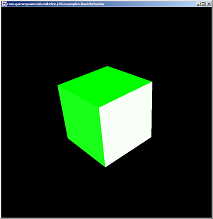Lee's Lessons
BasicBehavior
2000-05-24
Today's topic deals with the powerful, yet sometimes complex, world of Java3D behaviors. Behaviors are what
make the objects in Java3D 'do things'. These can be as simple as having an object just spin around constantly
to complex behaviors such as strange animations and paths, morphing, and much more. Today I'm going to start off
with a simple example just to show you how to add behavior to an object.
BasicBehavior.java

The screen is the same one as yesterdays. It is just a green cube. The user can then click on it and rotate it
and move it around and such. This, along with the previous examples, form the basis of almost all Java3D scenes.
The important code in this example is:
objTrans.setCapability ( TransformGroup.ALLOW_TRANSFORM_WRITE );
objTrans.setCapability ( TransformGroup.ALLOW_TRANSFORM_READ );
objTrans.setCapability ( TransformGroup.ENABLE_PICK_REPORTING );
This gives the objects in that transform group the ability to change at runtime. It also
enables pick reporting which allows it to be referenced through an event type system such
as a mouse click, etc.
PickRotateBehavior behavior
= new PickRotateBehavior(objRoot, canvas, bounds, PickObject.USE_BOUNDS);
objRoot.addChild(behavior);
This code is added to the branch group. It tells the Java3D internal compiler
(which compiles the scene) that this branch group can have pick behavior. This pick
behavior is the mouse events I mentioned before. So any branch group that has any object
that can move in it needs to have some type of behavior node added to it. Within that
branch group, you need to add the appropriate behavior to any transform group you want
to perform a certain way.
I updated my Java3D to 1.2. This does have some deprecated methods so I am going to have
to go back and see how Behaviors have changed in Java3D.
|